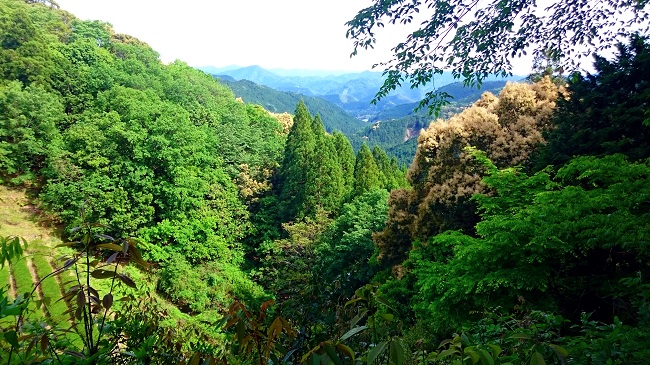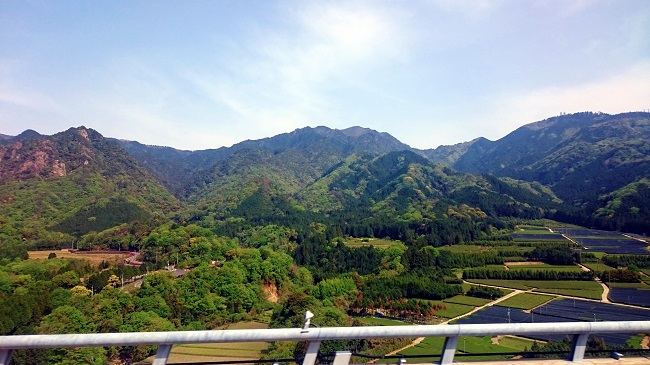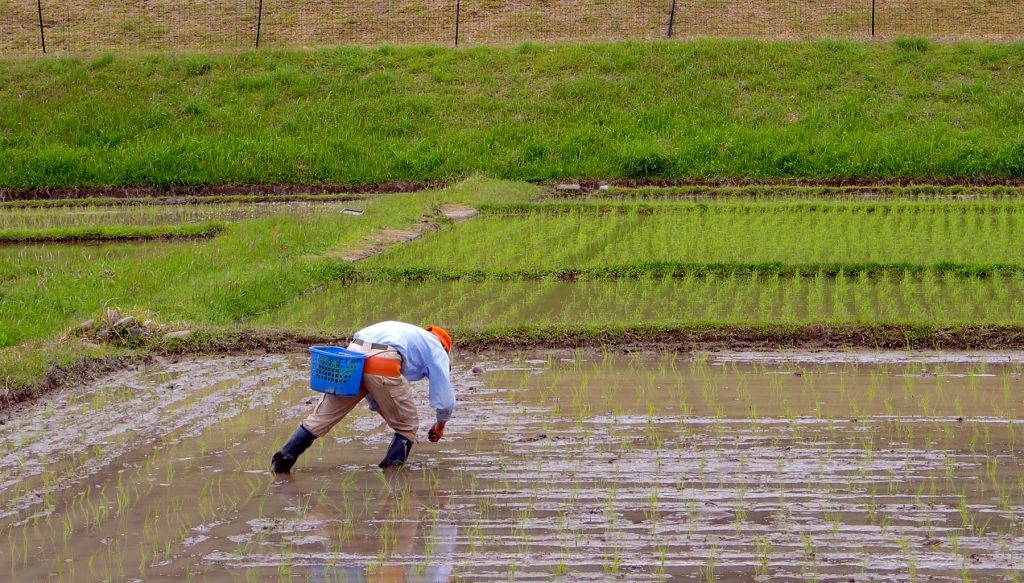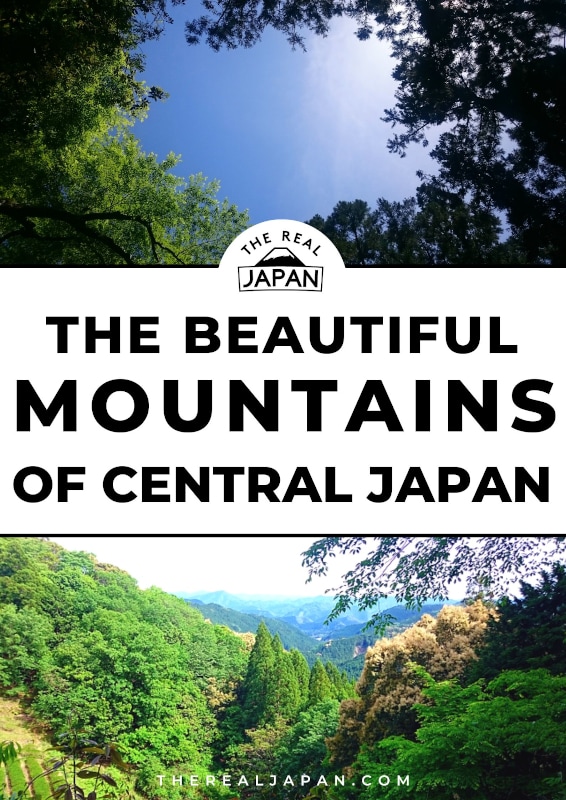I'm typing this on a bus bound for an area in the heart of Shiga Prefecture, which is in the middle of Honshu Island.
The views from the window are stunning, and impress upon me just how glorious the beautiful mountains of Japan are.
There's something quite distinctive about the country's densly forested mountains, and those of central Japan are rich with atmosphere.
The Beautiful Mountains of Central Japan
by Rob Dyer
The mountainous spine of Japan
Japan is a long, thin strip of a country, comprising some 6,800 islands. The main one, Honshu, is where you'll find most of the places you've heard of: Tokyo, Kyoto, Hiroshima, Osaka, Nara, etc.

Whilst the northern-most island of Hokkaido is rightly regarded as Japan's wild frontier, and the southern island of Okinawa the country's sub-tropical sun-worshippers' destination, the main island of Honshu is where you'll find the mountainous spine of the country that truly defines its character and people.
See Also: Hiking and Trekking The Japan Alps and Mount Fuji (Book Review)
72% of Japan is covered in mountains
An incredible 72% of the country is mountainous. A statistic that seems hard to reconcile with the image you see in the mainstream media outside of Japan.
The extensive mountain range (incorporating the Japanese Alps) virtually spans the entire length of Honshu and it is possible to drive (or ride a bus or train) through much of it.
Today, we're headed for an area east of lake Biwa-ko, north-west of Nagoya.
Remarkable feats of human engineering
Our journey began this morning in Kobe where we caught a coach that is currently driving across elevated highways that are remarkable feats of human engineering. As if saying to the gods of the mountains that we humans too can turn our hand to inspiring creations when we want to.
Although utilising tunnels which cut their way through the most obstructive mountains, the bulk of the route is via the elevated expressways that exemplify how Japan's impressive road infrastructure tames and occasionally dominates the landscape.
And, in between the mountains, the valleys.
You might also like: Nagoya City Guide: What Is Special About Nagoya?

Japan's many elevated highways provide terrific views of its mountainous interior
Rice fields clinging to every contour
Where rice fields cling to every contour of the undulating land. The rice fields looking like vast stepping stones weaving their way gradually up the mountainside as if for some ginormous god of agriculture to take to the top of each mountain in order to survey the remarkable efforts of his worshippers.
Farmers (none of them seemingly under 60 years of age) either utilise high-tech niche farming equipment and tractors, or through lack of funds, keep the hand-held traditions alive, their backs irreparably bent forwards in gruelling and yet still commonplace manual labour.

Many rice fields in Japan are still planted by hand
Afternoon sun shimmering off the water
The lowering and yet still hot afternoon sun shimmering off the water-filled rice paddies. The surface rippled by a gentle and welcome cool breeze. Kilometres of such views abruptly switch to fields of a modern crop: solar panels.
As is often the feeling, if you didn't know better, you'd be hard-pressed to believe Japan's economy was still in a desperate slump. The amount of on-going construction projects designed to extend the already extensive network of elevated highways Japan's vehicles rely upon would be noteworthy in any country.
A nation that defines resilience
But it seems in Japan this kind of thing is commonplace.
Just part of the nation's admirable stoic ability to absorb whatever the planet throws at it.
Be it earthquakes, tsunami's, typhoons, authorities resolutely repair, reconstruct, even develop in response and in doing so reinvigorate a nation that defines resilience.
If you're interested in going further north on Honshu, then I recommend reading this post: Hachimantai: Northern Tohoku’s Next Must-See Destination?
If you're thinking about driving in Japan, then I recommend reading this post: Driving In Japan Made Easy - A Beginner's Guide.

About the Author
A writer and publisher from England, Rob has been exploring Japan’s 6,800 islands since 2000. He specialises in travelling off the beaten track, whether on remote atolls or in the hidden streets of major cities. He’s the founder of TheRealJapan.com.
Central Japan Travel Planning Services
Have some questions about exploring central Japan? Want help planning a central Japan itinerary? The Real Japan offers some services that you might like to take a look at.
My Travel Planning Calls are ideal if you have a few unanswered questions about a trip you are planning, or would like feedback and suggestions on an itinerary you are building. Learn More HERE.
If you'd rather hand over all the hard work for planning an entire trip then my Travel Planning Service is tailor-made for you. Learn More HERE.
Further Japan travel guides, books and checklists are available in The Real Japan Travel Store.
What are your impressions of Japan's mountains? Not yet been? What would you seek out when you do go? I'd be interested to know - please leave a comment below...
If you enjoyed this post please share this photo:
Resources
Further Reading
Discover Honshu (Honshu Island Guide)
Hiking and Trekking The Japan Alps and Mount Fuji (Book Review)
Kinpusen-ji Temple in the Kii Mountains in Winter
Nagoya City Guide: What Is Special About Nagoya?
The Unique Restaurant on Wild Boar Mountain



An enjoyable article showing the beauty of Japans largest island. A lot can be learned from their resilience to adapt and could teach the world the best way forward.
Thanks for sharing your thoughts Carolyn. I agree. I’m from the UK where, for example, severe weather is thankfully rare. Japan manages to cope with serious extremes of weather every year. We could definitely learn a thing or two from them!